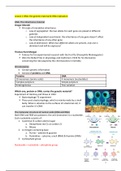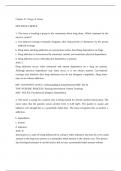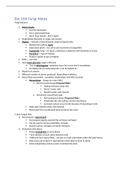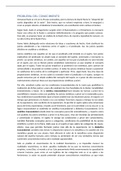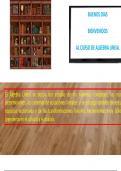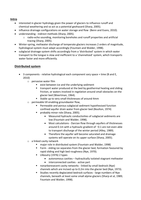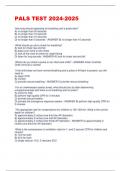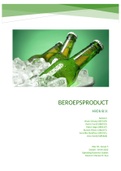6.1
Macromolecules- complex groups of organic molecules- made of amino acids,
the backbone of amino acids are -N-C-C
Types of macromolecules:
- Carbohydrates
- Lipids
- Proteins
- Nucleic acids
These can be assembled through
Dehydration Synthesis, two monomers turn into a polymer, water is
removed from the two monomers
and disassembled through
Hydrolysis, water being used to cut large molecules smaller, water gets
added back in
The chemicals in these processes will differ for each macromolecule
Carbohydrates
- Energy storage
- Made of carbon,oxygen, and hydrogen
Simple sugars- monosaccharides, single rings. Disaccharides, double ring
Complex sugars- polysaccharides, larger structures
Carbon, oxygen, hydrogen. 1:2:1 ratio
Lipids
- Save energy
- Body heat
- Protect organs
- Phospholipid bilayer
- Steroids and hormones
, - Insoluble in water
- Hydrophobic
for lipids a monomer is a fatty acid. When the monomers (fatty acids)
create a long chain, it becomes a polymer which is a lipid
Fatty acid is joined through dehydration synthesis
Triglyceride is a type of polymer, made up of one long glycerol and three
fatty acids.
Unsaturated fats
- Single bonds with neighbor hydrocarbon chain
- Animal origin
- Solid at room temp
Saturated fats
- Double bond in carbon chain
- Plant origin
- Solid at room temp
Proteins
Main functions
- Structural- muscles, hair, and nails
- Communication- neurotransmit, hormones
- Chemical reactions- enzymes
- Immunity- antigens and antibodies
Made of
- polymers of monomers of amino acids
- R variable
- Made of polypeptides of polymers of amino acids
- The amino acids are joined by the peptide bond through dehydration
synthesis
Nucleic acids
,Main functions
- Direct growth
- Develop
- Cell functions
- Characteristics
Two types
1. RNA
2. DNA
Made of
- Chains of subunits linked- nucleotide
- Phosphate, 5 carbon sugar, nitrogen containing base
Monomer- nucleotides
Polymer- nucleic acids
Catalyst- chemicals that control the speed of reactions without altering the
product formed by the reactions and without changing themselves
, Enzymes- type of catalyst that permits chemical reactions in the body at low
temperatures, reduces the amount of energy and works more efficiently resulting
in same product
Ends in “ase”
Substrate- molecules that enzyme attach with
How it works
- Substrate molecules combine with specific enzyme active site that has a
specific shape
- They attach to make an enzyme-substrate
- Molecules are changed
- Release with new made product
Cofactors and coenzymes help enzymes combine with substrate molecules
Factors affecting enzymes
- Cofactors and coenzymes
- Temperature, high temp break proteins, low temp fewer collision
- PH
- Enzyme concentrate
- Substrate concentrate
- Competitive inhibitors
6.2- digestive
4 stages of digestion: ingestions, digestion, absorption, egestion
Nutrient Carb -starch protein lipid DNA
digestion mouth Stomach Stomach SI and help of pancreas
absorption SI SI ST SI
Enzyme Amylase from salivary Pepsinogen- Lipase nuctletidas
glands pepsin
Secretion- break down of molecules by chemical means

